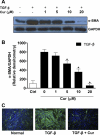Curcumin inhibits fibrosis-related effects in IPF fibroblasts and in mice following bleomycin-induced lung injury
- PMID: 20061443
- PMCID: PMC2867399
- DOI: 10.1152/ajplung.00002.2009
Curcumin inhibits fibrosis-related effects in IPF fibroblasts and in mice following bleomycin-induced lung injury
Abstract
Idiopathic pulmonary fibrosis (IPF) is a progressive and typically fatal lung disease for which no effective therapy has been identified. The disease is characterized by excessive collagen deposition, possibly in response to dysregulated wound healing. Mediators normally involved in would healing induce proliferation of fibroblasts and their differentiation to myofibroblasts that actively secrete collagen. Curcumin, a polyphenolic compound from turmeric, has been shown to exert a variety of biological effects. Effects on IPF and associated cell types remain unclear, however. We accordingly tested the ability of curcumin to inhibit proliferation and differentiation to myofibroblasts by human lung fibroblasts, including those from IPF patients. To further examine the potential usefulness of curcumin in IPF, we examined its ability to reduce fibrosis in bleomycin-treated mice. We show that curcumin effectively reduces profibrotic effects in both normal and IPF fibroblasts in vitro and that this reduction is accompanied by inhibition of key steps in the transforming growth factor-β (TGF-β) signaling pathway. In vivo, oral curcumin treatment showed no effect on important measures of bleomycin-induced injury in mice, whereas intraperitoneal curcumin administration effectively inhibited inflammation and collagen deposition along with a trend toward improved survival. Intraperitoneal curcumin reduced fibrotic progression even when administered after the acute bleomycin-induced inflammation had subsided. These results encourage further research on alternative formulations and routes of administration for this potentially attractive IPF therapy.
Figures








Similar articles
-
Biochanin-A ameliorates pulmonary fibrosis by suppressing the TGF-β mediated EMT, myofibroblasts differentiation and collagen deposition in in vitro and in vivo systems.Phytomedicine. 2020 Nov;78:153298. doi: 10.1016/j.phymed.2020.153298. Epub 2020 Aug 1. Phytomedicine. 2020. PMID: 32781391 Free PMC article.
-
Andrographolide ameliorates bleomycin-induced pulmonary fibrosis by suppressing cell proliferation and myofibroblast differentiation of fibroblasts via the TGF-β1-mediated Smad-dependent and -independent pathways.Toxicol Lett. 2020 Mar 15;321:103-113. doi: 10.1016/j.toxlet.2019.11.003. Epub 2019 Nov 6. Toxicol Lett. 2020. PMID: 31706003
-
Curdione ameliorates bleomycin-induced pulmonary fibrosis by repressing TGF-β-induced fibroblast to myofibroblast differentiation.Respir Res. 2020 Feb 19;21(1):58. doi: 10.1186/s12931-020-1300-y. Respir Res. 2020. PMID: 32075634 Free PMC article.
-
The pathogenesis of bleomycin-induced lung injury in animals and its applicability to human idiopathic pulmonary fibrosis.Exp Lung Res. 2015 Mar;41(2):57-73. doi: 10.3109/01902148.2014.979516. Epub 2014 Dec 16. Exp Lung Res. 2015. PMID: 25514507 Review.
-
Allies or enemies? The effect of regulatory T cells and related T lymphocytes on the profibrotic environment in bleomycin-injured lung mouse models.Clin Exp Med. 2023 Aug;23(4):1075-1088. doi: 10.1007/s10238-022-00945-7. Epub 2022 Nov 20. Clin Exp Med. 2023. PMID: 36403186 Free PMC article. Review.
Cited by
-
Modulators of inflammation in Bronchopulmonary Dysplasia.Semin Perinatol. 2018 Nov;42(7):459-470. doi: 10.1053/j.semperi.2018.09.009. Epub 2018 Oct 2. Semin Perinatol. 2018. PMID: 30446300 Free PMC article. Review.
-
Potential effects of medicinal plants and secondary metabolites on acute lung injury.Biomed Res Int. 2013;2013:576479. doi: 10.1155/2013/576479. Epub 2013 Oct 9. Biomed Res Int. 2013. PMID: 24224172 Free PMC article. Review.
-
Traditional Chinese medicine for pulmonary fibrosis therapy: Progress and future prospects.J Ethnopharmacol. 2017 Feb 23;198:45-63. doi: 10.1016/j.jep.2016.12.042. Epub 2016 Dec 28. J Ethnopharmacol. 2017. PMID: 28038955 Free PMC article. Review.
-
The Potential Effects of Curcumin on Pulmonary Fibroblasts of Idiopathic Pulmonary Fibrosis (IPF)-Approaching with Next-Generation Sequencing and Bioinformatics.Molecules. 2020 Nov 21;25(22):5458. doi: 10.3390/molecules25225458. Molecules. 2020. PMID: 33233354 Free PMC article.
-
Curcumin Inhibits Transforming Growth Factor β Induced Differentiation of Mouse Lung Fibroblasts to Myofibroblasts.Front Pharmacol. 2016 Nov 8;7:419. doi: 10.3389/fphar.2016.00419. eCollection 2016. Front Pharmacol. 2016. PMID: 27877129 Free PMC article.
References
-
- Batth BK, Tripathi R, Srinivas UK. Curcumin-induced differentiation of mouse embryonal carcinoma PCC4 cells. Differentiation 68: 133–140, 2001 - PubMed
-
- Burgess HA, Daugherty LE, Thatcher TH, Lakatos HF, Ray DM, Redonnet M, Phipps RP, Sime PJ. PPARγ agonists inhibit TGF-β induced pulmonary myofibroblast differentiation and collagen production: implications for therapy of lung fibrosis. Am J Physiol Lung Cell Mol Physiol 288: L1146–L1153, 2005 - PubMed
-
- Chen YR, Tan TH. Inhibition of the c-Jun N-terminal kinase (JNK) signaling pathway by curcumin. Oncogene 17: 173–178, 1998 - PubMed
-
- Cheng Y, Ping J, Liu C, Tan YZ, Chen GF. Study on effects of extracts from Salvia miltiorrhiza and Curcuma longa in inhibiting phosphorylated extracellular signal regulated kinase expression in rat's hepatic stellate cells. Chin J Integr Med 12: 207–211, 2006 - PubMed
Publication types
MeSH terms
Substances
Grants and funding
LinkOut - more resources
Full Text Sources
Other Literature Sources

